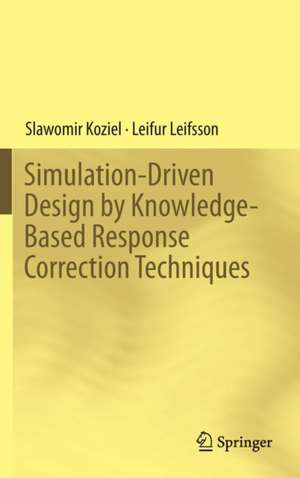Simulation-Driven Design by Knowledge-Based Response Correction Techniques
Autor Slawomir Koziel, Leifur Leifssonen Limba Engleză Hardback – 24 mai 2016
The book presents a general formulation of response correction techniques as well as a number of specific methods, including those based on correcting the low-fidelity model response (output space mapping, manifold mapping, adaptive response correction and shape-preserving response prediction), as well as on suitable modification of design specifications. Detailed formulations, application examples and the discussion of advantages and disadvantages of these techniques are also included. The book demonstrates the use of the discussed techniques for solving real-world engineering design problems, including applications in microwave engineering, antenna design, and aero/hydrodynamics.
| Toate formatele și edițiile | Preț | Express |
|---|---|---|
| Paperback (1) | 386.99 lei 6-8 săpt. | |
| Springer International Publishing – 27 mai 2018 | 386.99 lei 6-8 săpt. | |
| Hardback (1) | 394.29 lei 6-8 săpt. | |
| Springer International Publishing – 24 mai 2016 | 394.29 lei 6-8 săpt. |
Preț: 394.29 lei
Nou
Puncte Express: 591
Preț estimativ în valută:
75.44€ • 78.78$ • 62.30£
75.44€ • 78.78$ • 62.30£
Carte tipărită la comandă
Livrare economică 15-29 aprilie
Preluare comenzi: 021 569.72.76
Specificații
ISBN-13: 9783319301136
ISBN-10: 3319301136
Pagini: 256
Ilustrații: XI, 262 p. 167 illus., 93 illus. in color.
Dimensiuni: 155 x 235 x 18 mm
Greutate: 0.56 kg
Ediția:1st ed. 2016
Editura: Springer International Publishing
Colecția Springer
Locul publicării:Cham, Switzerland
ISBN-10: 3319301136
Pagini: 256
Ilustrații: XI, 262 p. 167 illus., 93 illus. in color.
Dimensiuni: 155 x 235 x 18 mm
Greutate: 0.56 kg
Ediția:1st ed. 2016
Editura: Springer International Publishing
Colecția Springer
Locul publicării:Cham, Switzerland
Cuprins
Introduction.- Simulation-Driven Design.- Fundamentals of Numerical Optimization.- Introduction to Surrogate-Based Modeling and Surrogate-Based Optimization.- Design Optimization Using Response Correction Techniques.- Surrogate-Based Optimization Using Parametric Response Correction.- Non-Parametric Response Correction Techniques.- Expedited Simulation-Driven Optimization Using Adaptively Adjusted Design Specification.- Surrogate-Assisted Design Optimization Using Response Features.- Enhancing Response Correction Techniques by Adjoint Sensitivity.- Multi-Objective Optimization Using Variable-Fidelity Models and Response Correction.- Physics-Base Surrogate Models Using Response Correction.- Summary and Discussion.- References.
Textul de pe ultima copertă
Focused on efficient simulation-driven multi-fidelity optimization techniques, this monograph on simulation-driven optimization covers simulations utilizing physics-based low-fidelity models, often based on coarse-discretization simulations or other types of simplified physics representations, such as analytical models. The methods presented in the book exploit as much as possible any knowledge about the system or device of interest embedded in the low-fidelity model with the purpose of reducing the computational overhead of the design process. Most of the techniques described in the book are of response correction type and can be split into parametric (usually based on analytical formulas) and non-parametric, i.e., not based on analytical formulas. The latter, while more complex in implementation, tend to be more efficient.
The book presents a general formulation of response correction techniques as well as a number of specific methods, including those based on correcting the low-fidelity model response (output space mapping, manifold mapping, adaptive response correction and shape-preserving response prediction), as well as on suitable modification of design specifications. Detailed formulations, application examples and the discussion of advantages and disadvantages of these techniques are also included. The book demonstrates the use of the discussed techniques for solving real-world engineering design problems, including applications in microwave engineering, antenna design, and aero/hydrodynamics.
The book presents a general formulation of response correction techniques as well as a number of specific methods, including those based on correcting the low-fidelity model response (output space mapping, manifold mapping, adaptive response correction and shape-preserving response prediction), as well as on suitable modification of design specifications. Detailed formulations, application examples and the discussion of advantages and disadvantages of these techniques are also included. The book demonstrates the use of the discussed techniques for solving real-world engineering design problems, including applications in microwave engineering, antenna design, and aero/hydrodynamics.
Caracteristici
Focused on efficient simulation-driven multi-fidelity optimization techniques Presents a general formulation of response correction techniques as well as a number of specific methods, including those based on correcting the low-fidelity model response Detailed formulations, application examples and the discussion of advantages and disadvantages of these techniques are also included Includes more than 100 high-resolution diagrams and figures
















